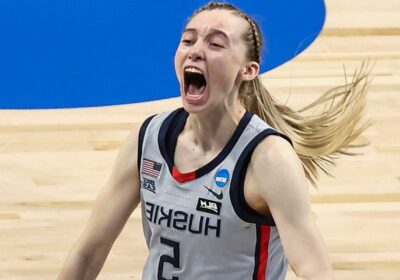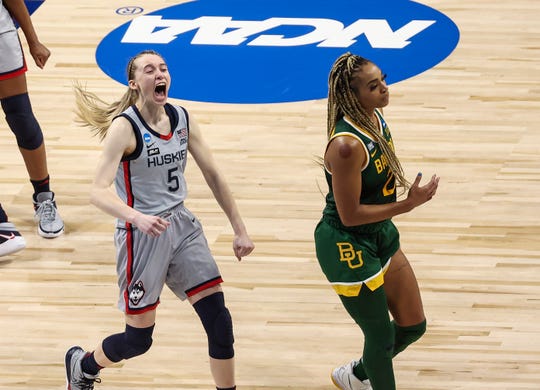Name, image and likeness: Key figures to know as new laws change college landscape

The landscape of college sports will forever change July 1 when legislation from seven states goes into effect which will allow student-athletes to monetize the use of their name, image and likeness without impacting their college eligibility.
It's a step into the unknown for the NCAA after more than a century running an organization steadfastly committed to an amateur model that resisted the call for enhanced benefits for the players beyond the cost of attendance at their respective universities.
The result could be a windfall for students that were restricted from earning money despite their popularity (think Zion Williamson). Those with significant social media followings are positioned to cash in on endorsements. Even those without major followings will be able to take advantage of commercial opportunities near their campuses.
How much money will be generated is uncertain, but navigating the new world will create significant challenges. In the arena will be several important figures that will play a role in shaping this new path. A look at seven of them:
Mark Emmert, NCAA president
With the NCAA unable to build consensus on crafting its own legislation to handle NIL and Congress not moving forward on a federal bill that would create uniform guidelines before July 1, there's going to have to be some accommodations made for athletes financially benefiting from their name, image and likeness in the seven states that passed laws.
It's expected there will be some form of bridge legislation by the NCAA to handle the temporary situation so that athletes don't lose eligibility as the governing body works toward getting passage of federal law. That temporary fix could come in late June.
As the leader of the NCAA, Emmert is being asked to guide the organization through this uncertainty. His biggest challenge will be finding a way to get federal legislation in a timely manner that guarantees some certainty for the organization. Having seven states with different laws on the books dealing with NIL is hard enough. More will be coming online soon. Having a uniform set of rules is critical if the NCAA is going to provide oversight into a complex arena that is sure to be ever-changing.
MORE: 10 questions explore how name, image and likeness will change college sports
MORE: State-by-state look at NIL laws that go into effect July 1
Maria Cantwell, Senator (D-Wash.)
If there is going to be a uniform NIL legislation passed at the federal level then Cantwell, the chair of the Senate Commerce Committee, which has jurisdiction over the matter, will be one of the key drivers of the legislation. In a divided Senate, passing any legislation is going to be difficult. However, what is different about the NIL issue is that members of both parties actually agree on the need for reform. But like most things, the devil is in the details. One interesting part of Cantwell's role as chair is that she was a senator when Emmert served as president of the University of Washington.
As the chair, she will have significant influence on potential legislation that needs 60 votes to pass the filibuster. Also on the committee is Sen. Jerry Moran (R-Kan.), who has authored a bill in hopes of bringing Republicans and Democrats to a compromise. While addressing the need for athletes to benefit from their name, image and likeness, it also would give the NCAA the legal protection it is seeking from antitrust lawsuits that challenge its athlete-compensation rules.
There's several other bills being proposed in this area that will see Cantwell tasked with finding a solution that can be signed into law by President Biden.
Paige Bueckers, Connecticut women's basketball
UConn Huskies guard Paige Bueckers (5) helped her team reach the women's Final Four during her freshman season. (Photo: Troy Taormina, USA TODAY Sports)
When the switch is flipped and athletes can start being compensated, the ones with the biggest social media followings stand to be among those reaping the rewards.
One might think football and men's basketball players would be the leaders in this area, but that wouldn't be entirely true. Yes, those sports have the most fans and generate the biggest television ratings. But the best men's basketball players aren't in school more than a year or two. The top football players leave in three seasons, often after becoming stars late in their career. Their windows can be very narrow.
Female athletes have a unique advantage in this area because they're on campus for their careers longer. It's also worth noting some major social platforms, like Instagram and TikTok, are more populated by females.
That's where Bueckers comes in. The national player of the year just completed her freshman season with the Huskies and led them to the Final Four. She already boasts 832,000 followers on Instagram. Compare that with fellow freshman Cade Cunningham of Oklahoma State, who has 234,000 on the platform, after an All-America season in men's basketball.
It stands Bueckers, with her position as one of the top players at one of the biggest women's basketball programs, could be among the leaders in generating opportunities for the next few years.
Olivia Dunne, LSU women's gymnastics
While Bueckers has an impressive social media profile, Dunne has cultivated an even greater presence, boasting more than 3.8 million followers on TikTok and more than 1 million on Instagram.
So how does a freshman gymnast reach this status? Helped by an accomplished junior career and active accounts offering insight into her life in and out of the gym, Dunne was getting millions of views on her TikTok account before stepping onto a college campus. With the doors being opened by NIL, she would be among the best athletes positioned to take advantage of the new model.
Like Bueckers, she likely will be on campus for another three years and can build on her social media foundation.
Paolo Banchero, Duke men's basketball
Set to start his career with the Blue Devils this fall, Banchero could be the first litmus test of how an incoming player can immediately capitalize on the national profile that comes from playing for one of the country's elite programs.
At 6-9 and 250 pounds, the state of Washington native will draw comparisons to Williamson because of his size and the school he chose. Banchero won't arrive in Durham, North Carolina, with the same social media following as his predecessor, but he's sure to be prominently featured if he can match the hype of being one of the top recruits this fall.
Even if he doesn't equal the phenomena that Williamson created during his one season at Duke two years ago, Banchero would certainly be an attractive person for advertisers if he can lead the Blue Devils into contention for a national title in coach Mike Krzyzewski's final year.
OPINION: Coach K set a standard at Duke no one in college basketball will ever reach
ROY ON COACH K: 'Phenomenal in everything he's done'
ANALYSIS: Major changing of guard coming to college basketball coaching
ANALYSIS: Duke passes on better options when selecting Coach K's replacement
Opendorse
So how do student-athletes transition to this new world where their brand can generate revenue for them? That's where companies like Opendorse will help guide them.
Founded in 2012, Opendorse is becoming a significant player in college athletics after starting its business with professional athletes. It already has relationships with some of the biggest schools, including Ohio State, Clemson, Texas and Florida. The company provides athletes education on their brand and how to build it and then facilitates opportunities for them to monetize that growth.
One example of success is its work with Fresno State women's basketball players Haley and Hanna Cavinder. The twins started doing coordinated TikTok videos that built their account to 3 million followers. In an article by the Fresno Bee, Hanna Cavinder credited Opendorse as a source of information and guidance for the players as they built their brand. According to the story, Opendorse estimates a TikTok post from the twins' account could be worth almost $35,000 and there is the possibility of earning more than $500,000 per year.
Opendorse isn't the only company in this space and the competition is going to be fierce. These businesses are sure to grow and impact the market potential for the athletes. It's already apparent that schools must have these resources as part of their recruiting process because it will factor into the assessment high school players make when choosing a college.
Supreme Court
The decision by the high court to hear the NCAA's appeal of the NCAA v. Alston case meant there would be a ruling on the ability of the organization to limit the benefit related to education given to student-athletes. In rulings by a federal district court in California and the U.S. Court of Appeals Ninth District, the limitations were found to have violated federal antitrust laws. Arguments were heard by the Supreme Court in March and a decision on the case is imminent.
While this case doesn't directly address the issues of NIL, a negative outcome for the NCAA could severely impact the foundation of its amateurism model. If the court rules limitations on compensation violate the law, then any restrictions on how much athletes can make on name, image and likeness could fall into this category. The court could also rule in favor of the NCAA and give the organization more authority to craft rules compensation limits.
It's important to note that any decision by the court could be washed away by federal legislation. However, a strong result in either direction could influence how Congress chooses to act with its NIL bill.
Follow colleges reporter Erick Smith on Twitter @ericksmith
Source: Read Full Article
